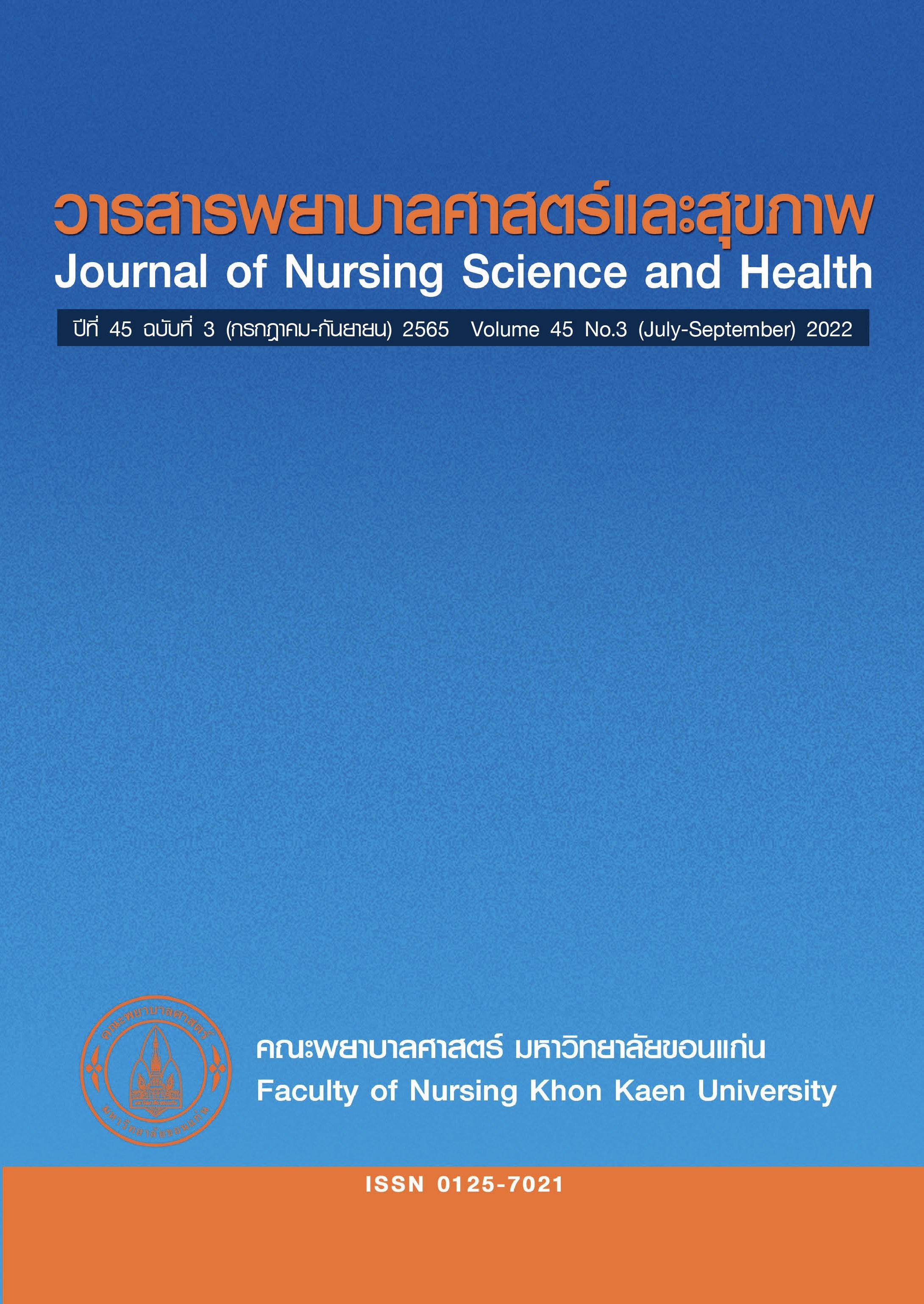ความชุกและความสอดคล้องของความเครียด ความเสี่ยงเป็นโรคซึมเศร้า และภาวะซึมเศร้าของหญิงตั้งครรภ์
คำสำคัญ:
ความเครียด, ความเสี่ยงเป็นโรคซึมเศร้า , ภาวะซึมเศร้า , หญิงตั้งครรภ์บทคัดย่อ
การวิจัยเชิงพรรณนานี้ มีวัตถุประสงค์เพื่อศึกษาความชุกและความสอดคล้องของความเครียด ความเสี่ยงเป็นโรคซึมเศร้า และภาวะซึมเศร้าในหญิงตั้งครรภ์ จำนวน 97 คน ที่มาฝากครรภ์ครั้งแรกที่โรงพยาบาลพังโคน จังหวัดสกลนคร โดยใช้แบบประเมินความเครียด 5 คำถาม (ST-5) แบบประเมินความเสี่ยงเป็นโรคซึมเศร้า 2 คำถาม (2Q) และแบบประเมินภาวะซึมเศร้า 9 คำถาม (9Q) วิเคราะห์ข้อมูลด้วยสถิติเชิงพรรณนาและ kappa test
ผลการวิจัย พบว่าความเครียดของหญิงตั้งครรภ์ส่วนใหญ่อยู่ในระดับเครียดน้อย (87.6%) มีความเสี่ยงเป็นโรคซึมเศร้า ร้อยละ 10.3 และมีภาวะซึมเศร้าร้อยละ 9.3 ผลการประเมินพบว่าความเครียดไม่มีความสอดคล้องกับความเสี่ยงเป็นโรคซึมเศร้าและภาวะซึมเศร้าอย่างมีนัยสำคัญทางสถิติที่ ระดับ .05 (kappa=.022, p=.378; kappa=.094, p=.346 ตามลำดับ) และผลการประเมินความเสี่ยงเป็นโรคซึมเศร้าไม่มีความสอดคล้องกับภาวะซึมเศร้าอย่างมีนัยสำคัญทางสถิติที่ ระดับ .05 (kappa=.001, p=.978)
สรุปว่าหญิงตั้งครรภ์ควรได้รับการประเมินสุขภาพจิตทั้งความเครียด ความเสี่ยงเป็นโรคซึมเศร้า และภาวะซึมเศร้าไปพร้อมๆ กัน เนื่องจากแบบประเมินทั้ง 3 ชนิด ไม่มีความสอดคล้องกัน หากพบภาวะใดผิดปกติในแบบประเมินใด ก็ตามควรได้รับการให้คำปรึกษา และส่งต่อเจ้าหน้าที่ที่รับผิดชอบเพื่อรับการดูแลทางด้านจิตใจและสังคมต่อไป
เอกสารอ้างอิง
Lowdermilk D, Perry S, Cashion K. Maternal and women’s health care. 10th ed. USA: Elsevier; 2012.
Kiruthiga V. Emotive whims distressing pregnant women. Int J Eng Technol 2017;4(8):2194-6.
Shahhousseini Z, Pourasghar M, Khalilian A, Salehi F. A review of the effects of anxiety during pregnancy on children’s health. J Int Med Sci Acad 2015;27(3):200-2.
Drake E, White MS. Postpartum adaptations and nursing care. In: Murray S, Mckinney E, Holub KS, Jones R, editors. Foundations of maternal-newborn and women’s health nursing. 7th ed. St. Louis Missouri: Elsevier;2019.p.458-64.
Gulamani SS, Premji SS, Kanji Z, Azam ZI. A review of postpartum depression, preterm birth, and culture. J Perinat Neonatal Nurs 2013;27(1):52–9.
Tahirkheli NN, Cherry AS, Tackett AP, McCaffree MA, Gillaspy SR. Postpartum depression on the neonatal intensive care unit: Current perspectives. Int J Women's Health 2014;24(6): 975-87.
Sriarporn P, Soonthornlimsiri N, Chantrathit K, Deluea J, Nanchai J, Khiekha P. Factors associated with depression after the birth of the mother and father with the first child. Nursing J 2015;42(3):37-50. (in Thai)
Department of Mental Health, Ministry of Public Health. Guidelines for using of mental health tools for public health personnel in community hospitals. Nonthaburi: Office of Mental Health Promotion and Development, Department of Mental Health; 2015. (in Thai)
Department of Health, Ministry of Public Health. Maternal and child health diary. Nonthaburi: Ministry of Public Health; 2020. (in Thai)
Phumek S, Kovavisarat E, Kuanphakul M, Sangpitak W. Factors predicting depression of postpartum mothers who come to Rajavithi Hospital. J Nurs Healthc Res 2019;35(3):158-70. (in Thai)
Anusornteerakul S, Ounkaew A, Hanklar S, Sitthi K, Booranasun T. The study of mental health and adaptation among postpartum mothers. Research report. Udonthani: Faculty of Nursing, Ratchathani University, Udonthani Campus; 2021. (in Thai)
Seatang O, Kaewjiboon J, Rueankul T. Stress and factors related to stress among elderly pregnancy. JNHR 2021;22(3):71-83. (in Thai)
Prechakornkanokkul P, Wattananukulkiat S, Phanphruk W. Stress and coping of industrial pregnant women in the Suranaree industrial zone, Nakhon Ratchasima Province. Journal of Nursing Science & Health 2012;35(2):53-61. (in Thai)
Bootchaingam P, Gongjan S. Prevalence of perinatal depression in LomKao Crown Prince Hospital. Mahasarakham Hospital Journal 2018;15(3):93-102. (in Thai)
Wongniyom K, Apinuntavech S. The prevalence and associated factors of depression in teenage pregnancy at Siriraj Hospital. J Psychiatr Assoc Thailand 2014;59(3):195-205. (in Thai)
Silpakit O. Srithanya's stress measurement form. J Ment Health Thail 2008;16(3):177-85. (in Thai)
Arunpongpaisan S, Kongsuk T, Maneeton N, Maneeton B, Wannasawak K, Leechongpermpoon J, et al. Development and validity of the 2-questions type depressive disorder screening in Isaan Thai communities. J Psychiatr Assoc Thailand 2007;52(2):138-48. (in Thai)
Kongsuk T, Arunpongpaisan S, Chanthong S, Pruekkanon B, Sukhaw S, Leechongpermpoon J. Criterion-related validity of the 9 questions depression rating scale revised for Thai central dialect. J Psychiatr Assoc Thailand 2018;63(4):321-34. (in Thai)
Cochran WC. Sampling techniques. 2nd ed. New York: John Wiley & Sons; 1973.
Cox JL, Holden JM, Sagovsky R. Detection of postnatal depression: development of the 10-item Edinburgh Postnatal Depression Scale. Br J Psychiatry 1987;150:782-6.
ดาวน์โหลด
เผยแพร่แล้ว
รูปแบบการอ้างอิง
ฉบับ
ประเภทบทความ
สัญญาอนุญาต
ลิขสิทธิ์ (c) 2022 วารสารพยาบาลศาสตร์และสุขภาพ

อนุญาตภายใต้เงื่อนไข Creative Commons Attribution-NonCommercial-NoDerivatives 4.0 International License.
วารสารพยาบาลศาสตร์และสุขภาพเป็นเจ้าของลิขสิทธิ์ในการเผยแพร่ผลงานที่ตีพิมพ์ห้ามผู้ใดนำบทความที่ได้รับการตีพิมพ์ในวารสารพยาบาลศาสตร์และสุขภาพไปเผยแพร่ในลักษณะต่าง ๆ ดังนี้ การนำบทความไปเผยแพร่ออนไลน์ การถ่ายเอกสารบทความเพื่อกิจกรรมที่ไม่ใช่การเรียนการสอน การส่งบทความไปตีพิมพ์เผยแพร่ที่อื่น ยกเว้นเสียแต่ได้รับอนุญาตจากวารสารพยาบาลศาสตร์และสุขภาพ



